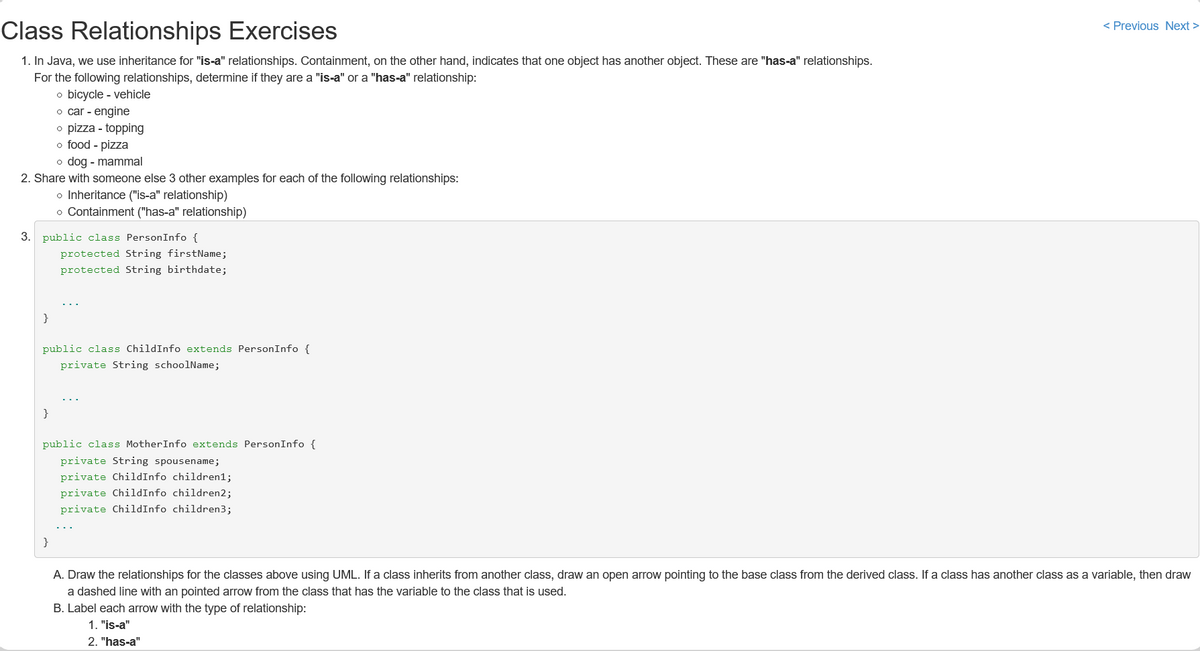< Previous Next Class Relationships Exercises 1. In Java, we use inheritance for "is-a" relationships. Containment, on the other hand, indicates that one object has another object. These are "has-a" relationships. For the following relationships, determine if they are a "is-a" or a "has-a" relationship: o bicycle - vehicle o car - engine o pizza - topping o food - pizza o dog - mammal 2. Share with someone else 3 other examples for each of the following relationships: o Inheritance ("is-a" relationship) o Containment ("has-a" relationship) 3. public class PersonInfo { protected String firstName; protected String birthdate; public class ChildInfo extends PersonInfo { private String schoolName; ... public class MotherInfo extends PersonInfo { private String spousename; vate ChildInfo children1; private ChildInfo children2; private ChildInfo children3; ... A. Draw the relationships for the classes above using UML. If a class inherits from another class, draw an open arrow pointing to the base class from the derived class. If a class has another class as a variable, then draw a dashed line with an pointed arrow from the class that has the variable to the class that is used. B. Label each arrow with the type of relationship: 1. "is-a" 2. "has-a"
< Previous Next Class Relationships Exercises 1. In Java, we use inheritance for "is-a" relationships. Containment, on the other hand, indicates that one object has another object. These are "has-a" relationships. For the following relationships, determine if they are a "is-a" or a "has-a" relationship: o bicycle - vehicle o car - engine o pizza - topping o food - pizza o dog - mammal 2. Share with someone else 3 other examples for each of the following relationships: o Inheritance ("is-a" relationship) o Containment ("has-a" relationship) 3. public class PersonInfo { protected String firstName; protected String birthdate; public class ChildInfo extends PersonInfo { private String schoolName; ... public class MotherInfo extends PersonInfo { private String spousename; vate ChildInfo children1; private ChildInfo children2; private ChildInfo children3; ... A. Draw the relationships for the classes above using UML. If a class inherits from another class, draw an open arrow pointing to the base class from the derived class. If a class has another class as a variable, then draw a dashed line with an pointed arrow from the class that has the variable to the class that is used. B. Label each arrow with the type of relationship: 1. "is-a" 2. "has-a"
C++ Programming: From Problem Analysis to Program Design
8th Edition
ISBN:9781337102087
Author:D. S. Malik
Publisher:D. S. Malik
Chapter10: Classes And Data Abstraction
Section: Chapter Questions
Problem 13SA
Related questions
Question
100%

Transcribed Image Text:< Previous Next >
Class Relationships Exercises
1. In Java, we use inheritance for "is-a" relationships. Containment, on the other hand, indicates that one object has another object. These are "has-a" relationships.
For the following relationships, determine if they are a "is-a" or a "has-a" relationship:
o bicycle - vehicle
o car - engine
o pizza - topping
o food - pizza
o dog - mammal
2. Share with someone else 3 other examples for each of the following relationships:
o Inheritance ("is-a" relationship)
o Containment ("has-a" relationship)
3. public class PersonInfo {
protected String firstName;
protected String birthdate;
}
public class ChildInfo extends PersonInfo {
private String schoolName;
}
public class MotherInfo extends PersonInfo {
private String spousename;
private ChildInfo children1;
private ChildInfo children2;
private ChildInfo children3;
...
}
A. Draw the relationships for the classes above using UML. If a class inherits from another class, draw an open arrow pointing to the base class from the derived class. If a class has another class as a variable, then draw
a dashed line with an pointed arrow from the class that has the variable to the class that is used.
B. Label each arrow with the type of relationship:
1. "is-a"
2. "has-a"
Expert Solution
This question has been solved!
Explore an expertly crafted, step-by-step solution for a thorough understanding of key concepts.
Step by step
Solved in 2 steps with 1 images

Knowledge Booster
Learn more about
Need a deep-dive on the concept behind this application? Look no further. Learn more about this topic, computer-science and related others by exploring similar questions and additional content below.Recommended textbooks for you

C++ Programming: From Problem Analysis to Program…
Computer Science
ISBN:
9781337102087
Author:
D. S. Malik
Publisher:
Cengage Learning

C++ Programming: From Problem Analysis to Program…
Computer Science
ISBN:
9781337102087
Author:
D. S. Malik
Publisher:
Cengage Learning